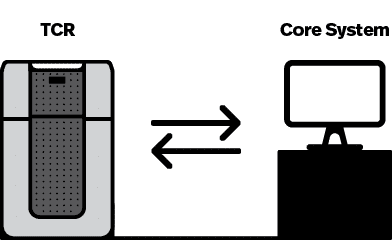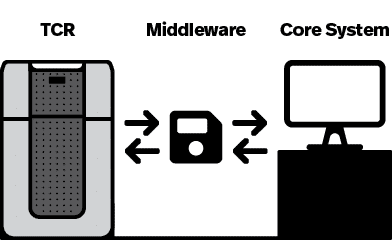Executive Summary
Determining the best way to operate teller cash recyclers (TCR) in your branch environment is a difficult task. Often it takes a coordinated effort between multiple departments to make the final decision of how to assimilate the cash recyclers efficiently and easily into your branch. One of the keys to making the correct decision is to explore the pros and cons of the options available.
There are essentially three choices to consider:
- Directly integrating with your current core software platform;
- Operating the cash recycler in a standalone environment; and
- Using a middleware application.
This white paper will provide background information that will help you make an informed decision on which integration solution is right for your unique situation.
Direct Integration
Direct integration is frequently touted as the best option for deploying Teller Cash Recyclers (TCRs) in retail branch environments. When successfully directly integrated, use of TCRs no longer requires double-key entries during transactions or balancing. Additionally, direct integration eliminates the need to support an additional application independent of the teller application.
Unfortunately, direct integrations are often costly, proprietary to a manufacturer or application platform, and limited in terms of supported device functionality.
Here are more pros and cons of direct integration.
Pros
- Eliminate double keying – no intermediary between teller and device
- Supported by core – device supported / certified by teller app provider
- Enterprise rollout – often lower cost (licenses, fees) for larger rollouts
- Ease of use – limited adjustment to current teller workflow
Cons
- Universal API – often limits device performance and capabilities
- Hard coded / direct – costly and subject to long lead times
- Costly for core – app provider has limited incentive to “certify” devices
- Support – can create confusion relative to root cause – hardware or software issue?
Direct integration is widely considered the future of TCR integration. Taking into account the size and scope of your implementation plan, in addition to identifying required device functionality will help you estimate the return on direct integration investment.
Standalone Teller Cash Recycler
Standalone implementations leverage application software, loaded on and driven by the local PC, to drive the TCR independent of the teller application. Tellers toggle between the two applications on their desktop (often employing “hot keys”), requiring double keying of amounts in both the standalone application and their teller application.
Pro
- Low cost – no need for development work or application customization
- Highly stable – applications designed specifically to support TCR functionality
- Application agnostic – not tied to specific application, protects investment
- Ease of use – simple to train, use, manage exception conditions
Con
- Double-keying – creates opportunity for error in cash handling
- Balancing – creates need for added step in teller balancing
- Enterprise rollout – can be cost-prohibitive in larger implementations
- Support – generates need to support yet another application in branches
Depending upon your unique branch characteristics and goals for teller cash recycler adoption, standalone application deployment may be the best option.
Middleware
Application middleware attempts to address the functionality issues inherent in standalone applications while also providing functionality that is often lost in direct integrations. In these environments (much like standalone environments), application middleware is resident on the local PC. However, application middleware “maps” commands and command statuses to and from the TCR and teller application eliminating the need for double keying by the teller (save for balancing).
Pros
- Low cost – limited / no need for custom application development
- Minimal double keying – eliminate need to double key outside of balancing
- Application agnostic – not tied to specific application, protects investment
- Ease of use – simple to train, use, manage exception conditions
Cons
- Added step in balancing – need for added step, opportunity for error
- Enterprise rollout – can be cost-prohibitive in larger implementations
- Teller application changes – may threaten stability of “mapping”
- Support – generates need to support yet another application in branches
Soft interfaces can be an attractive alternative to lower-functionality standalone or more costly direct integration options.
Conclusion
Educating yourself on the available integration strategies and carefully comparing and contrasting your options will help ensure that a smart choice is made. Be sure to take the time to weigh your software options before making any integration decision.




